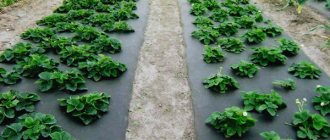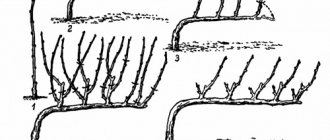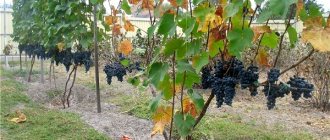Friendly plants
When planting different crops on the same row, it is necessary to take into account the soil structure, watering regime, age of the bushes and plant compatibility. The ripening of vines is well influenced by cereals and herbaceous plants. Rye, wheat, and oats will be beneficial for grapes. You can plant quinoa and woodlice, they won’t hurt.
Cereals are good for grapes
If you plant grapes with berries, they will acquire a specific taste. The best way to reflect the proximity to strawberries. Then the bunches will be well candied and become larger.
Onions and garlic are excellent neighbors for any vineyard. They will be able to protect the bushes from pests. But some varieties of onions can be harmful to young bushes.
Varieties of radishes, beets and cucumbers grow well between the rows of grapes. Dill and spinach are also grape friendly. Sowing legumes will enrich the soil with nitrogen. Some flowers will be useful for grapes. Plantings of currants and raspberries will take root between the rows of grapes. Caring for currants can be combined with pruning grapes in the fall.
What is a catarrh and why is it needed (or not needed)
By catarrhization one should understand the removal of the superficial (dew) roots of the grapevine, which are dew collectors. Let's figure out whether it is necessary to carry out catarrhization in your vineyard, and find out its pros and cons.
Experienced winegrowers remove surface roots for the following reasons:
- phylloxera often clings to them;
- they are always damaged by drought;
- If at the end of summer after dry weather the air humidity rises sharply, the surface roots quickly collect moisture, which leads to significant cracking of the berries.
However, experts believe that catarrhization is not always beneficial for grapes:
- Firstly, removing dew roots always causes wounds and stress for the plant; after cutting off the surface roots, some shoots may droop right before your eyes, since they fed from them. In addition, if the weather is damp and cool, carrying out catarrhosis can contribute to the development of such a dangerous disease as grape cancer. We will talk in more detail about grape medicine in the following articles.
- Secondly, in areas with heavy compacted soils, surface roots are simply necessary for grapes, especially in places with high groundwater levels. When the groundwater rises too high, the deep roots suffer from a lack of oxygen, and the vine survives precisely at the expense of the surface roots, which serve as a buffer, balancing soil water surges.
And in order to prevent surface roots from losing moisture in dry weather, the soil under the bushes needs to be mulched. Mulch conserves water well and helps improve soil structure and increase fertility. This is discussed in more detail in the article “Organic farming: stop destroying the soil by digging and weeding.” Mulched soil absorbs moisture from the air and promotes its fall in the form of dew; accordingly, moisture surges are smoothed out and dew roots are not affected; in addition, with heavy rainfall, cracking of the berries is not observed.
Grape antagonists
Summer residents with experience know which plant neighbors conflict with each other and which do not. It is very difficult to detect something wrong; all processes occur unnoticed by the winegrower. Only at the end of the season will it be possible to understand that something is wrong. A real war can break out between root systems to obtain nutrients. By releasing toxins, neighbors can destroy each other and make the soil unsuitable for the development of young shoots.
Among the vegetables that can harm grapes are the following:
- Potato
- Eggplant
- Leek (Pearl Onion)
- Corn
- Pepper (red and capsicum)
- Tomatoes
- Chives
You can't plant corn with grapes
Sorrel and parsley are bad neighbors; they can harm the grapes. Some wildflowers can also conflict with grapes. It is imperative to get rid of dandelions, nettles, cornflowers, plantain and wormwood. It is better not to plant some varieties of flowers near the vineyard: carnations, clematis and calendula. Sunflowers should also not be located near grapes. If compatibility with other plants is not taken into account, the plantings may die.
Beans
Beans grow well in the vicinity of many crops: cucumbers, tomatoes, sweet corn, radishes, radishes, spinach, mustard. They are also compatible with potatoes, but in this case you need to know one thing: beans should be planted only along the edge of the potato field, because they absorb large amounts of nutrients. Otherwise, the potato tubers will not receive enough necessary elements (in particular, potassium) and will grow small.
There are also useful herbs for beans that improve the development of the plant. These are basil, borage, lavender, oregano, rosemary, yarrow.
However, beans should not be planted with any types of onions, garlic, peas, marigolds and wormwood.
Onions next to grapes
Gardeners often grow onions between rows. The main thing is to fertilize the soil and avoid over-watering the planting. It is necessary to loosen the soil every 10 days. It will be possible to harvest in the fall. Harvesting is done when the leaves and neck of the plants have dried. The onions will need to be left for 4-5 days to ripen.
Onions are a good neighbor for grapes
By repeatedly thinning the planting, you can grow onions for greens. Then it can be collected in the summer. Pearl onions and chives should not be planted near the vineyard.
Principles of competent partnership
When choosing a neighbor for grapes, you should pay attention not only to the properties of a particular crop, but also to the following characteristics:
- height of an adult plant;
- features of care;
- lighting requirements.
Why such difficulties? Let's explain:
- Tall crops with dense foliage, such as tomatoes or beans, will shade the lower part of the vine where the berry clusters form.
- An adult, fully formed grape bush creates a thick shadow around itself, which means light-loving crops will feel uncomfortable next to it.
- The opposing demands of neighboring crops on environmental conditions greatly complicate the care of plantings.
How to plant cucumbers between trellises
Good neighbors for grapes are cucumbers. One of the best varieties for growing together is the Relay variety. It is intended for greenhouses, but can also produce crops in open areas.
The best variety for joint cultivation relay race
First you need to germinate the seeds of this variety. To do this, they are soaked in a piece of gauze and waited for several days. You need to make cones out of paper 5 cm in diameter and 10 cm long. They need to be filled with soil and the sprouted seeds planted there.
The glasses are left in a sunny, warm place. In a few days they will sprout. Plants should be planted in glasses in April. At the end of May, they need to be taken out to a shaded place in the fresh air so that they adapt better. In June you can plant the plants in a permanent place. You can fertilize the soil with manure or compost. Plantings between rows are located every 25-30 cm.
Watering should be regular. Half a bucket for one planting. If you care for it correctly, the plant will begin to curl around the trellises, reaching a height of 2-3 meters. From 10 such plants it will be possible to harvest 1 kg per day. The season can last until the end of August.
Landing according to Karasev
This method has been tested by many years of experience and ensures good development of the bush with any forming method. Here it is important to follow two basic rules, namely that, firstly, the roots should not be buried more than 40 centimeters - this will facilitate timely warming up and will not slow down the growth of the bush. Secondly, the roots must have a large supply of moisture, which can only be achieved at great depths. This seemingly contradiction can be avoided if the planting pits are properly arranged.
The depth of such a pit should be 70 cm, width - 40 cm, length - 80 cm, it should be extended in the direction from south to north. The dug earth is placed in a certain place, where it is mixed with sand and humus (sand - one bucket, humus - two). Then we make drainage: pour a shovel of ash at the bottom of the hole, on top of which a layer of gravel, crushed stone or expanded clay 10 cm thick is laid (this will be approximately 3.5 buckets).
On the south side of the pit, a piece of pipe with a diameter of 10-15 cm is stuck into the gravel - any pipe will do (plastic, asbestos-cement). The length of the pipe should be such that it rises 7-10 cm above the soil surface. After this, various sticks and planks are laid on the gravel so that our drainage does not become covered with earth from the very beginning.
Next, we fill the hole with a 20 cm high layer of earth mixed with sand and humus, and 10-15 cm north of the pipe we make a small mound, place a seedling on it, straightening the roots well, and fill the hole completely with earth. When planting, the seedling must be tilted from the pipe to the center of the hole - this will provide it with good heating. When planting, the two lower buds must be buried in the ground; one or two are left on the surface, depending on the expected formation of the future vine. We will talk in more detail about the formation methods in the following articles.
A bush planted in this way does not need to be fertilized in the first year, you only need to water it, for which every week until mid-summer we pour 1-2 buckets of water into the pipe, depending on weather conditions. It is easy to water through a pipe, the water does not evaporate, and its consumption is much less. Next year, organic fertilizers and various other fertilizers can be delivered to the roots in the same way.
The top of the pipe must be covered with a brick or a tin can, this will protect it from clogging and any living creatures, such as frogs or toads, getting inside. In subsequent years, it is necessary to water and “feed” the planted bush in this way according to the usual scheme, which we will consider in more detail in the following articles.
Growing strawberries in rows
The soil between the grape bushes has high humidity. Trellis cast a shadow and protect the ground from increased levels of solar radiation. These factors are ideal for growing strawberries.
Since the roots of grapes and strawberries are located at different depths, competition between root systems is minimal. Both plants respond positively to organic fertilizers.
Strawberries can only be planted between young grape bushes. The distance to planting should be more than 50 cm. You need to dig a longitudinal hole in the shape of an inverted trapezoid. This will retain moisture in the soil. If the humidity is too high, the bed should be raised above ground level. It would not hurt to install a drainage system and drip irrigation.
By the third year, you will need to replace the old bed with new plants and re-fertilize. The area of the bed will decrease over time as the grapes grow. The distance to the trellis will increase and be at least 1 meter.
Planting with strawberries will affect the taste
A strawberry bed is the best place to test watering. The roots of grapes are deeper than the roots of strawberries. It is important to distribute the water evenly when watering. Strawberries are an excellent neighbor for grapes.
Galkin trenches
The organization of special trenches, 70 cm deep, 30-40 cm wide, the length can be arbitrary, will help to enlarge the formation, strengthen the bushes and increase the amount of harvest. Drainage (crushed stone, expanded clay, gravel) 10 cm thick is also poured into the bottom of the trench, and pipes are installed every four meters. To prevent the drainage from swimming, slate or planks are laid on top of it, and this entire “structure” is filled with earth mixed with sand and humus at a ratio of 4:2:1 (earth, humus, sand, respectively).
Grape bushes are planted in ordinary holes on both sides of the trench at a distance of a meter and a half. The effect in this case is even better, since the trench is a huge container with an improved environment common to all roots. The roots of young seedlings very quickly find their way into the trench and develop well there, which helps to increase the power of the bush, which means the amount of harvest also increases.
It’s easy to water such a vineyard—put a hose into the pipe, and water flows all night; the number of necessary waterings over the entire summer ranges from 2 to 4, depending on the weather.
It should be noted that if you have loose fertile soils on your site, then drainage is not necessary; you can fill holes or trenches with well-ripened humus.
Roses
One of the most terrible diseases that can affect large plots is mildew. Because this fungus is carried by wind, it can quickly infect and destroy large areas of vineyards. Roses are also susceptible to this disease, but it is less persistent. The rose bush becomes infected one day faster.
In the old days, roses were planted near the grapes, since freely grazing horses could accidentally wander into the plot. However, over time, this tradition lost its relevance and roses were no longer planted as a fence. In the middle of the 19th century, an epidemic of another disease called phylloxera swept through the vineyards. Only the Occitanie vineyard in France survived.
Roses of different varieties can become an indicator of not only diseases. They react to high levels of heavy metals in the soil. Although there are fewer diseases in the north than in the south, preventive treatments should still be carried out. In such cases, the rose bush is an ideal neighbor for the grapes.
Roses are disease indicators
Agricultural technology for roses and grapes is the same. Covering is also convenient. It is important to choose durable material to protect the grapes for the winter. If you choose one that is too thin, it will break on the rose thorns.
Flowers should be planted at the end of May, when the soil is warm. Seedlings need to be watered every two weeks. Proper pruning will turn your bushes into real works of art.
Weeds
Among weeds there are both beneficial neighbors and pests. If grape varieties grow on bare soil, the plantings will be severely delayed in development. This is due to the fact that weeds act as green fertilizers. Without them, the soil becomes dry and hardened. After 9-10 years, the plantings may die.
Young bushes do not need to be sown with herbs. Weeds will take away nutrients from them and will not allow them to develop normally. In the third year, you can sow the soil with low-growing grasses. Wild weeds can also be left. But if bluebells or wheatgrass flowers grow in excess, then you need to get rid of them.
There may be grass between the rows
Weeds also need to be removed when the bush density is high and the formations are low. If this is not done, the grapes will die from the fungus when the weeds grow to the level of the bunches. You should not cultivate the soil too close to the trunk, as this can lead to damage to the bush.
The best solution is to sow different grass crops between the rows. This will prevent harmful weeds from growing and increase soil fertility. But you can plant herbs only if there is sufficient feeding area for the bushes.
Green manure
Grapes require a special soil structure to grow. The soil is permeated by plants and their roots. When they die, they will leave cavities in the soil. They can be filled by the root system of the grapes. The above-ground part and dead roots will turn into excellent fertilizer for the vineyard.
Crops that grow quickly and produce a lot of green mass are used as green fertilizers. Cereals and legumes are most suitable. They can be planted in late summer.
Earthworms are the best indicator of soil quality. If you sow a fast-growing variety of grass on green fertilizer and then roll it, an excellent cover will form. A large number of worms will appear in such soil, and the percentage of humus will increase.
Grasses must be constantly mowed. Tall grass takes away the nutrients the grapes need in the spring. After a few years, a humus layer will form from rotted grass clippings. It allows the soil to better absorb and distribute moisture.










